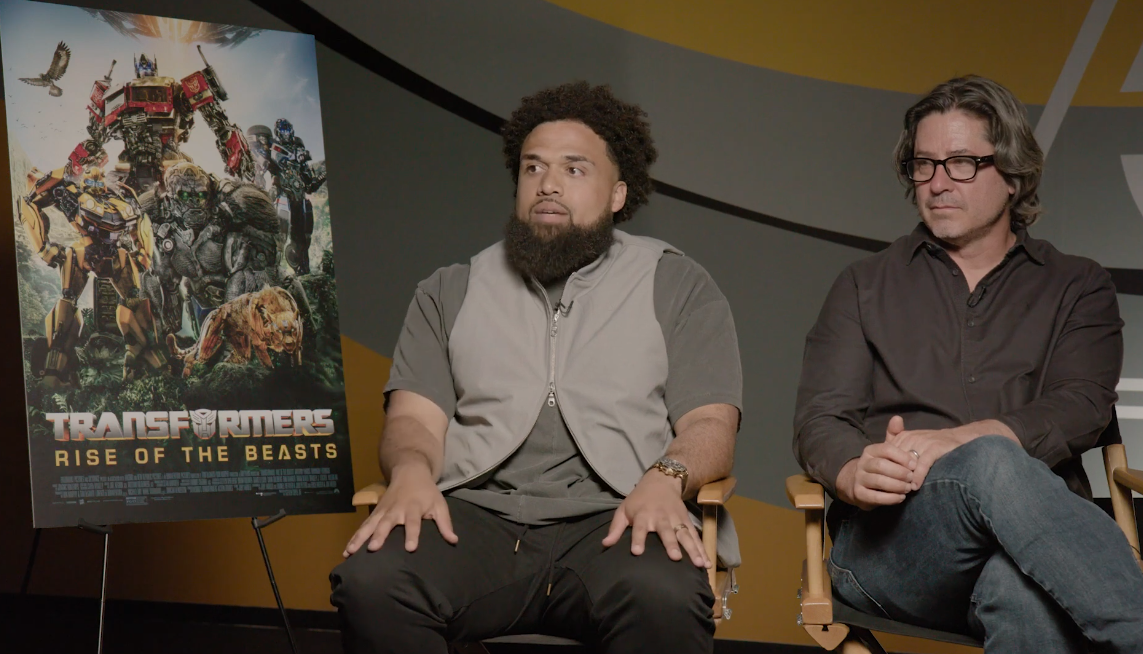July 12, 2023
To pump up the July 11 PVOD release of Transformers: Rise of the Beasts, Paramount Home Entertainment invited a group of journalists and social media influencers to the Porsche Driving Experience in Carson, Calif., to get a real feel for the action scenes in the film, in which one of the German carmaker’s most iconic models – the 911 Carrera RS 3.8 – takes on the character of Mirage. Mirage is an Autobot, an alien-robot that can transform into a car, joining in the battle to help save the earth.
After taking a few spins around the track as well as a water skid in which he was sure he was going to die, Media Play News publisher Thomas K. Arnold sat down with the film’s director, Steven Caple Jr., and second unit director James Madigan, who was responsible for capturing footage of the “Mirage” Porsche, for a brief interview.
(Note: The PVOD release of Transformers: Rise of the Beasts will be followed by the film’s Oct. 10 arrival on DVD, Blu-ray Disc, 4K Ultra HD Blu-ray and 4K Ultra HD Steelbook.
MPN: How do you come into a franchise such as Transformers and make it your own?
Caple: Oh, that’s a great question. For me, it always starts with characters and story. As generic as that may sound, if I bring something to the table, who in this movie do I connect with, who can I relate to. Me, as a person, I’m already different than Travis Knight and Michael Bay, so for me it’s how can I bring me to the table, and that goes into every sequence, every line, trying to bring authenticity to the world, and New York City in the ’90s, and when I’m in places like Peru, how can I really … I didn’t want to go there for the scope and the action, I wanted to go there to capture the culture, the beauty and the history and the ruins, things like that. That feels like me — and that’s how I can feel like I can bring a stamp to any franchise — it’s finding those moment and those things like that.
Madigan (addressing Caple): I remember in Peru you were telling me about the first time you were pitching the movie, and how it existed before then, and really bringing the stories, the issue of healthcare, and things you would never imagine seeing in a Transformers movie … and how once you have something that’s rooted in a character struggle that people can relate to, I think you right there have a different movie, something that’s got a lot of heart…. Just reading the script — I obviously came on later, and there was already a script that you developed — and as soon as you read the script, from page one, it’s like wow, this is great, this is something that draws you in.
MPN: Steven, what have you learned since your first feature film, The Land, and how did you apply what you’ve learned to the Transformers?
Caple: Transformers was a huge learning curve for me. There were a lot of really cool things, and I basically went to film school all over again. I worked hard with the visual effects department, especially Gary [Brozenich], who was our visual effects supervisor. Every weekend during prep, I’d literally take classes. He would break down how a shot is done in the CG world, and it was super helpful for me to find my rhythm and my style and how I wanted to approach everything. It was far different from anything I’ve actually worked on before. The things I can say that I pulled from it? Many action sequences, always tracking a character, always keep an eye on the story itself and make sure that every scene is sort of motivated, that there isn’t a scene for the sake of a scene, that there isn’t a fight for the sake of fighting, there isn’t a skateboard move for the sake of having a skateboard move. Everything was motivated by the characters themselves, and that’s something I stayed true to throughout.
MPN: James, you’re Mr. Action. When trying to maximize the action value, so to speak, in a movie, how do you balance the actual action with the close-up shots of the character to reflect that action?
Madigan: That’s something that we always try to start with. Everything that motivates all the action, as Steven was saying, comes from character and story. So with that as our foundation, that just drives how we shoot everything. So in terms of doing closeup shots with the actual actors, Steven will go through and get those first, and I will make sure everything I shoot will blend with that perfectly. So in a way you’re kind of editing in your mind as you shoot, because we’re out there, it might be raining, it might be snowing, who knows what it’s going to be, so you might have to change a plan or whatever. But as long as you’re staying focused on what the actual story is and what the character mindset is at the time, that really just drives all of your decisions.
